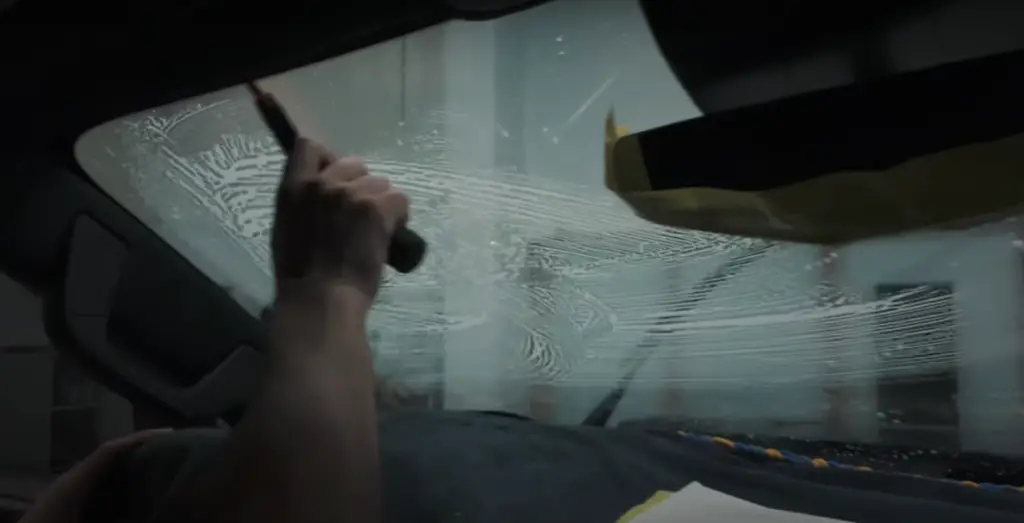Yes, but windshield tinting is heavily regulated. Most laws only allow a small top strip to be tinted. Always check local regulations before applying tint.
When it comes to car customization, window tinting is one of the most popular modifications. It’s not just about aesthetics—window tint can provide protection from UV rays, improve privacy, and enhance comfort by reducing heat. But what about tinting your windshield? While tinting side and rear windows is common and widely accepted, tinting your windshield involves more complexities due to visibility and safety concerns.
In this blog post, we’ll dive into the topic of windshield tinting: is it legal, what are the benefits, and what should you know before tinting your windshield?

Contents
What is Windshield Tinting?
Window tinting involves applying a thin, transparent film to the glass. This film reduces the amount of visible light, infrared radiation, and ultraviolet rays that enter the vehicle. There are various types of window tints, including dyed, metalized, carbon, ceramic, and hybrid films, each offering different levels of protection, clarity, and cost.
Windshield tinting refers to applying this same film on your front windshield. Unlike side or rear windows, the front windshield must maintain high visibility to ensure driver safety, so tinting it is subject to much stricter regulations.
Is Windshield Tinting Legal?
The legality of windshield tinting varies widely from one region to another, and it’s essential to understand the local laws before proceeding. Laws typically regulate the amount of visible light that must pass through the windshield, known as the Visible Light Transmission (VLT) percentage.
In the United States, for example, windshield tinting is generally allowed only above the AS-1 line, which is a marking on most car windshields that indicates where the visible part of the windshield begins. The area below this line, which is the main viewing area for the driver, must remain untinted in most states.
Here’s a quick breakdown of windshield tint laws in the U.S.:
- Permitted Tint Level: Windshields are usually required to allow at least 70% of light through in most states.
- Tint Location: Tinting is generally only allowed above the AS-1 line or the top few inches of the windshield (often referred to as the visor strip).
- Exemptions: Some states offer medical exemptions, allowing drivers with specific medical conditions to tint their windshields more heavily.
Example of state laws:
- California: Only a 4-inch strip at the top of the windshield is allowed for tinting.
- Florida: Allows non-reflective tint above the AS-1 line.
- Texas: Tinting above the AS-1 line is allowed, but the rest of the windshield must have at least 25% VLT.
Internationally, countries have similar but varied laws:
- United Kingdom: Windshield tinting laws are stringent, requiring at least 75% VLT.
- Australia: Each state has its own laws, but most states allow no more than 10% tint on the front windshield, excluding the top strip.
Benefits of Windshield Tinting
Although windshield tinting is restricted in many places, there are numerous benefits to applying a legal, compliant tint:
- UV Protection: Windshield tinting can block up to 99% of harmful UV rays, protecting your skin and preventing the car’s interior from fading or cracking over time.
- Reduced Glare: A high-quality tint can reduce glare from the sun and other vehicles’ headlights, making driving more comfortable and safer, especially during dawn or dusk.
- Improved Temperature Control: Tinted windows can help reduce the amount of heat that enters your car, keeping the interior cooler. This can be especially beneficial during summer months and in hot climates.
- Enhanced Privacy: While tinting your side windows may provide most of the privacy benefits, a lightly tinted windshield can still make it harder for people outside to see into your car without obstructing your own view.
- Increased Safety: In the event of an accident, tint film can help hold shattered glass together, preventing it from flying and reducing the risk of injury.

Types of Windshield Tint
Windshield tint comes in different types, each with its own features and benefits. Below are the most common types:
- Dyed Film: This is the most affordable type of tint and works by absorbing sunlight. While it does provide some UV protection, it tends to fade over time and doesn’t block much heat.
- Metalized Film: Metalized tint contains metallic particles that reflect heat and UV rays. It’s more durable than dyed film but can interfere with cell phone, GPS, and radio signals.
- Carbon Film: Carbon tint offers good UV protection and heat reduction without the signal interference of metalized tint. It also has a matte finish that enhances the car’s appearance.
- Ceramic Film: Ceramic tint is the most expensive but provides superior UV protection, glare reduction, and heat rejection. It doesn’t interfere with electronic signals and maintains high visibility, making it a popular choice for windshield applications.
- Hybrid Film: A combination of dyed and metalized films, hybrid tint offers a balance of performance and affordability. It provides good heat reduction and UV protection without the excessive reflectivity or signal interference of metalized film.
Things to Consider Before Tinting the Windshield
Before deciding to tint your windshield, consider these important factors:
- Local Regulations: Make sure to research your local laws regarding windshield tinting. Failing to comply with these regulations can result in fines or your vehicle being deemed non-roadworthy.
- Professional Installation: Always have your tint installed by a professional. DIY kits may be cheaper, but improper installation can lead to air bubbles, peeling, or even damage to the windshield. A professional installer will also ensure that the tint complies with local laws.
- Visibility and Safety: Your windshield is critical for visibility, so it’s important to choose a tint that won’t obstruct your view. Ceramic tints, for example, provide excellent UV and heat protection without compromising clarity.
- Medical Exemptions: Some individuals may be eligible for medical exemptions allowing darker windshield tints due to conditions like lupus or skin cancer. Check with your local DMV or equivalent authority to see if you qualify.
- Resale Value: Excessively dark tints or non-compliant modifications may negatively affect your car’s resale value. Buyers may be deterred by the prospect of having to remove illegal tints to pass inspections.
Potential Downsides of Windshield Tinting
While windshield tinting offers several benefits, there are also some drawbacks to consider:
- Legality Issues: Even a slight miscalculation in the VLT of your windshield tint can result in fines or failed vehicle inspections.
- Insurance Concerns: Illegal or overly dark windshield tint can affect the car insurance policy. If the tint is found to have contributed to an accident or failed inspection, your coverage could be affected.
- Visibility at Night: If you choose a tint that is too dark, it can make night driving more difficult. Even a legal tint can reduce visibility slightly, so it’s crucial to consider your driving habits and how much nighttime driving you do.
- Cost: High-quality windshield tint, especially ceramic options, can be costly. While it provides excellent performance, the price might be prohibitive for some.
Frequently Asked Questions
Here are some FAQs about about tinting windshield –
- Can I tint my entire windshield?
In most places, tinting the entire windshield is not legal. Usually, only a small strip at the top, above the AS-1 line, is allowed to be tinted. However, some states and countries may allow a lighter tint (such as 70% VLT) on the entire windshield. - What is the AS-1 line on a windshield?
The AS-1 line is a marking on a car’s windshield that indicates the highest point at which tinting is allowed. The area above this line can typically be tinted, but below it, the windshield must remain clear in most states. - Can I get a medical exemption for windshield tinting?
Yes, many states allow for medical exemptions if you have a condition that makes you sensitive to sunlight, such as lupus or skin cancer. You will need to provide medical documentation and apply for the exemption through your local DMV. - Will tinting my windshield affect my visibility?
While a light, high-quality tint like ceramic film should not significantly impact visibility, darker tints can make it harder to see, especially at night. It’s essential to choose a tint with a high VLT to maintain visibility while driving. - How much does it cost to tint a windshield?
The cost of tinting a windshield varies depending on the type of tint and the vehicle. On average, you can expect to pay between $100 and $400 for windshield tinting, with ceramic tints being on the higher end of the price range.
Conclusion
Tinting your windshield can provide significant benefits, from improved UV protection to enhanced comfort and reduced glare. However, it’s important to understand the legal implications and safety concerns associated with windshield tinting. Always ensure your tint complies with local laws, and consider opting for high-quality materials and professional installation for the best results.
If you decide to tint your windshield, ceramic tints are often the best option due to their superior performance in terms of UV protection, heat rejection, and clarity. Regardless of which tint you choose, safety and legality should always come first.